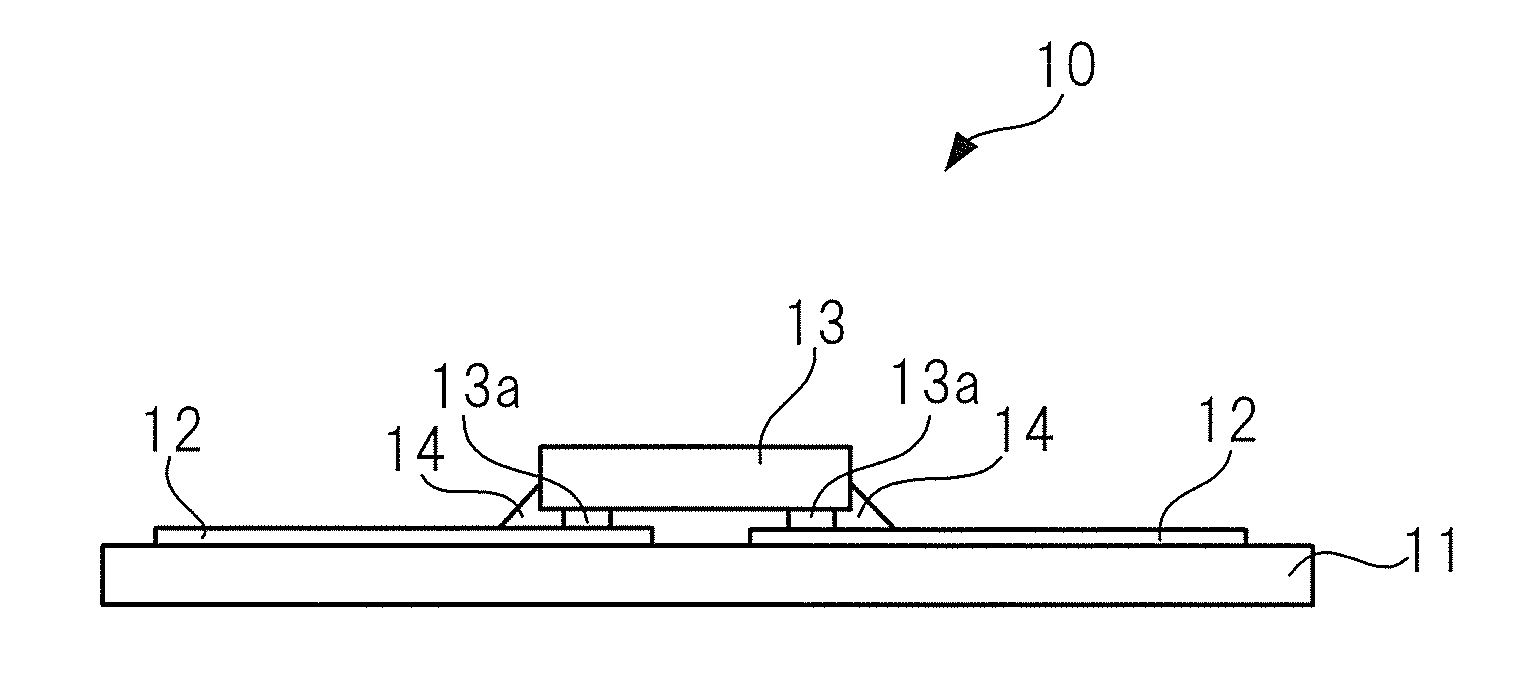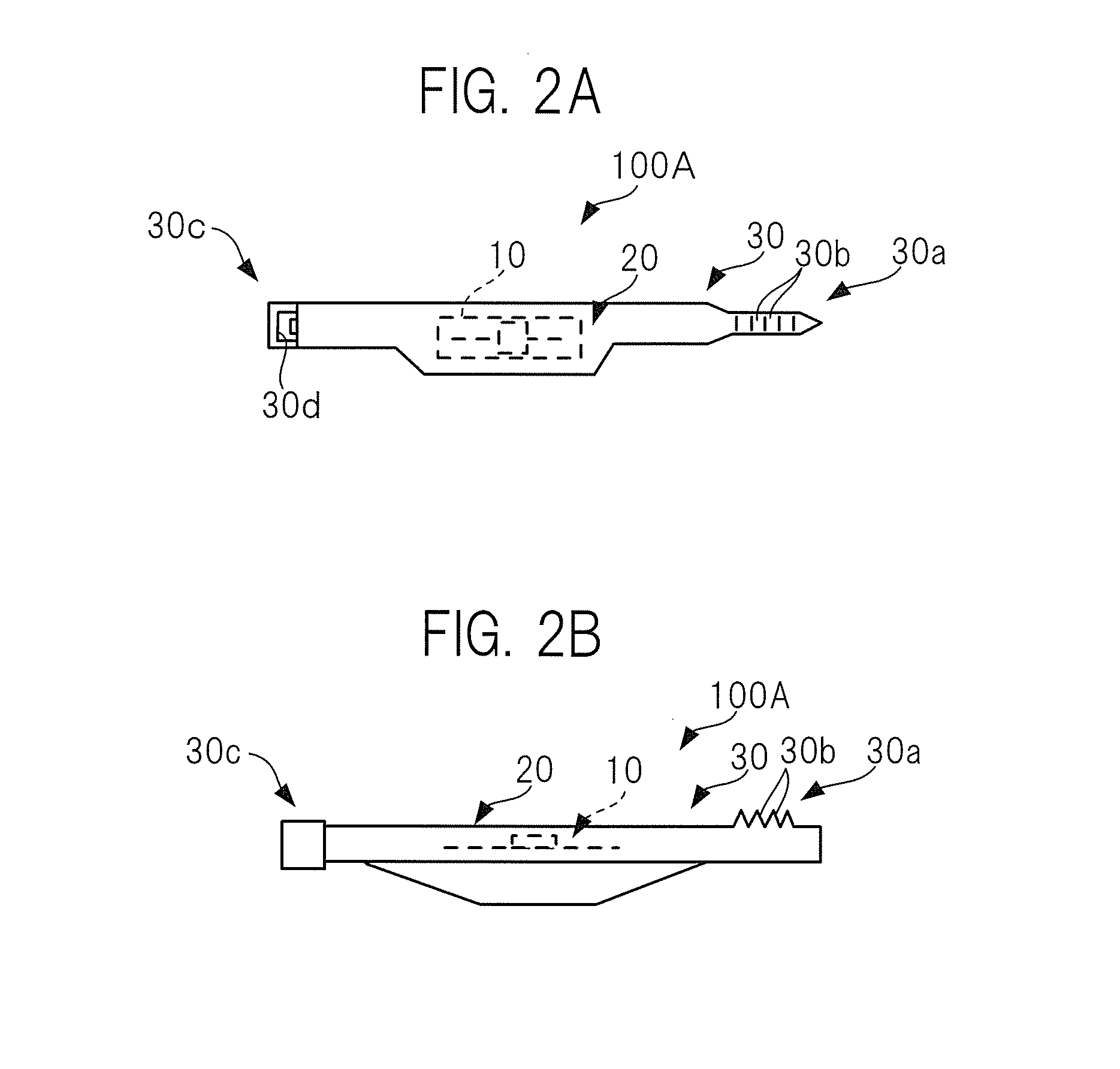RFID tag and manufacturing method of RFID tag
a technology of radio frequency identification and manufacturing method, which is applied in the direction of burglar alarm mechanical actuation, burglar alarm by hand-portable article removal, etc., can solve the problems of reducing the available distance of communication, and affecting the stability of space maintaining members, so as to prevent falling off of space maintaining members. , the effect of stabilizing the space maintaining members
- Summary
- Abstract
- Description
- Claims
- Application Information
AI Technical Summary
Benefits of technology
Problems solved by technology
Method used
Image
Examples
first embodiment
[0089]FIG. 2 illustrates a RFID tag of the present invention. FIG. 2A is a plan view, whereas FIG. 2B is a side view.
[0090]A RFID tag 100A is composed of an inlay 10 having an antenna 12 and a circuit chip 13 as illustrated in FIG. 1; an enclosure 20 for enclosing the inlay 10; a belt 30 that is integrally formed with the enclosure 20 and extends from the enclosure 20 in right and left directions in FIG. 2; and a spacer 40 that is fixed (here, adhered) to a surface of the enclosure 20 on an article 90 side (see FIG. 3).
[0091]The enclosure 20 and the belt 30 are made of a flexible material like rubber or plastic, and the inlay 10 is completely sealed in the enclosure 20. In one end 30a of the belt 30, notches 30b with bumps are formed, and on the other end 30C of the belt 30, a coupling section 30d having a through hole for letting through the one end 30a is formed.
[0092]The spacer 40 is a single continuous member and made of a material in the form of rubber that follows deformation....
second embodiment
[0117]FIG. 7 illustrates a RFID tag of the present invention.
[0118]Only a spacer 41 is different in a RFID tag 100B illustrated in FIG. 7 as compared to the RFID tag illustrated in FIG. 2. The spacer 41 of the RFID tag 100B illustrated in FIG. 7 is a single continuous member as a whole, made of a foam material in which bubbles are dispersed, for example, rubber foam.
[0119]In general, a rubber material has a large dielectric loss and is apt to lose energy of electromagnetic waves, so that a communication distance is short. As such, here, the spacer 41 is made of a foam material such as rubber foam, for allowing air to be present inside the spacer 41 to suppress reduction in a communication distance. Although a rubber material has a dielectric rate of substantially 3 to 5 in general, it is possible to reduce an actual dielectric rate substantially to 2 by having air in a part. This improves an antenna gain without downsizing the antenna 12 to the extent of unnecessary dimensions.
third embodiment
[0120]FIG. 8 illustrates a RFID tag of the present invention, and FIG. 9 illustrates a state in which the RFID tag illustrated in FIG. 8 surrounds an article.
[0121]Also in a RFID tag 100C illustrated in FIG. 8, only a spacer 42 is different, as compared to the RFID tag 100A illustrated in FIG. 2. The spacer 42 of the RFID tag 100C illustrated in FIG. 8 is a single continuous member having a structure in which rigid members 42d made of a material such as plastic are dispersedly arranged in a flexible member 42a made of a material such as rubber. As such, when the RFID tag 100C surrounds the article 90, by the rigid members 42d dispersedly arranged in the spacer 42, a spacing between the antenna 12 constituting the inlay 10 and the article 90 is controlled irrespective of a wrapping strength of the belt 30, so that a predetermined antenna characteristics can be obtained.
PUM
| Property | Measurement | Unit |
|---|---|---|
| communication distance | aaaaa | aaaaa |
| thickness | aaaaa | aaaaa |
| thickness | aaaaa | aaaaa |
Abstract
Description
Claims
Application Information
 Login to View More
Login to View More - R&D
- Intellectual Property
- Life Sciences
- Materials
- Tech Scout
- Unparalleled Data Quality
- Higher Quality Content
- 60% Fewer Hallucinations
Browse by: Latest US Patents, China's latest patents, Technical Efficacy Thesaurus, Application Domain, Technology Topic, Popular Technical Reports.
© 2025 PatSnap. All rights reserved.Legal|Privacy policy|Modern Slavery Act Transparency Statement|Sitemap|About US| Contact US: help@patsnap.com



